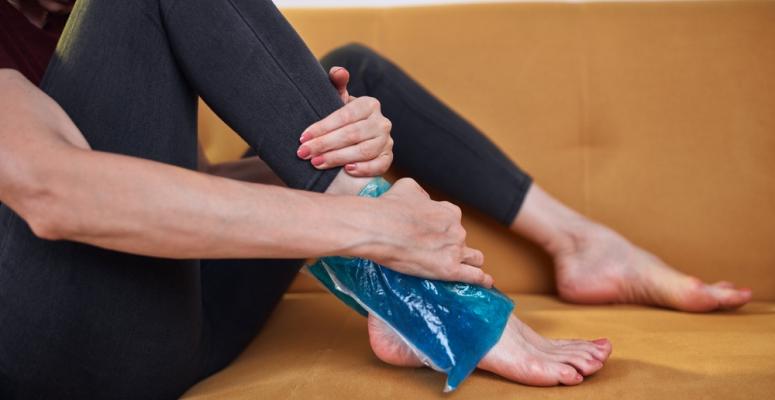
- How long should swelling last after an injury?
- Why does swelling occur after an injury, anyway?
- How long is too long for swelling to last after an injury?
- What can you do to make swelling go down faster?
- Does physical therapy reduce swelling?
- Alliance PTP is ready to help you find top-notch PT for post-injury swelling
How long should swelling last after an injury? When should you be worried about swelling? What can you do to make the swelling go down faster?
We'll answer all those questions and more below.
How long should swelling last after an injury?
There's no easy answer to this question. Some injuries swell for only a few days while others stay swollen for weeks or even months. This timeline depends on the severity of your injury and the steps you take to manage it.
Other factors can impact swelling time, too. For example, if there is an obstruction in your lymph system, your body may not be able to drain out the waste produced during the inflammation process. Thus, your post-injury swelling may last longer than it would otherwise.
Why does swelling occur after an injury, anyway?
Swelling is a sign that your body is fighting against potential infections. When you injure a body part, your body sends lots of blood to that area to ensure it has plenty of white blood cells to fight infection and nutrients to help rebuild the affected tissue.
Simultaneously, this process produces waste byproducts that your body immediately starts filtering out. All of this extra fluid (blood and waste) creates inflammation and swelling. This process can also cause your injured body part to feel warm, painful or tender to the touch.
How long is too long for swelling to last after an injury?
Most swelling peaks within one to three days and stays swollen for a period of time before it starts to dissipate. The exact timeline varies from person to person. If your injury continues to swell for more than a few days, it might be best to call a medical professional. The same goes for injuries that stay swollen for more than a few weeks ” it won't hurt to check in with a doctor to make sure everything is healing properly.
What can you do to make swelling go down faster?
There are a few things you can do to reduce the amount of time your swelling lasts after an injury. Here are a few examples:
- Rest ” Using an injured body can irritate your bones or soft tissue, causing even more swelling and inflammation. Combined with the fact that activity stimulates circulation and can send an excess of blood rushing to your body part, it's typically a good idea to rest your injured limbs while they recover.
- Ice ” Ice is a well-known swelling reduction method. Applying ice constricts the blood vessels, allowing less blood to flow to the injury site. While this can prevent nutrients from reaching the injury, it also helps reduce swelling.
- Compression ” Wearing a compression sleeve around your injured body part places pressure on it. This promotes blood flow to ensure that your blood is moving efficiently to and from your injury. It also helps to squeeze out the waste fluids that are created during the inflammatory process. The exit of all this liquid can reduce swelling.
- Elevation ” Elevation pairs well with rest. Try to keep your injured body parts above the level of your heart while you're sitting or lying down. This allows the waste fluids to drain away from the injury, which reduces swelling and can help you recover faster.
Does physical therapy reduce swelling?
Physical therapy helps to reduce inflammation in some patients. If you visit a physical therapist in your area, they will assess your injury to determine if it's been swollen for too long. Then, they'll determine a course of action of treating it and helping you to manage any pain.
Here are some techniques that physical therapists use to reduce post-injury swelling:
- Manual therapy ” Manual therapy is a treatment method where the physical therapist manually manipulates your bones or soft tissue with their hands. Manual therapy can relieve tension, reduce inflammation and decrease swelling.
- Therapeutic exercises ” Your physical therapist will walk you through a series of exercises that help you rebuild muscle in your injured area while reducing swelling. They can also teach you how to exercise at home in a way where you avoid reinjuring yourself and restarting the swelling process.
- Injury-specific treatments ” Some injuries can benefit from specialized physical therapy modalities. For instance, they may apply myofascial release or strain-counterstrain therapy to help reduce swelling.
Ultimately, if you're wondering if your swelling has lasted too long after your injury, your physical therapist will be able to answer that question. Even better, they'll help you to reduce your inflammation so the swelling goes away.
Alliance PTP is ready to help you find top-notch PT for post-injury swelling
At Alliance Physical Therapy Partners, we're proudly bringing together physical therapy practices across the country to help people get the high-quality PT they need. Want to see a physical therapist in person? We can put you in touch with an Alliance PTP partner that's close to you and that can help you address your injury swelling.
Not keen on in-person PT sessions or not close to an Alliance PTP partner? No worries. We also offer effective and affordable virtual physical therapy through our Agile Virtual Physical Therapy platform.
Contact our team today so we can help you find the most effective physical therapy services for your injury or condition.
Get Help at a Location Near You
